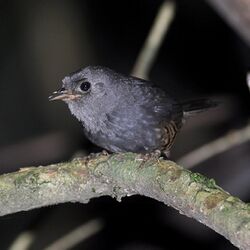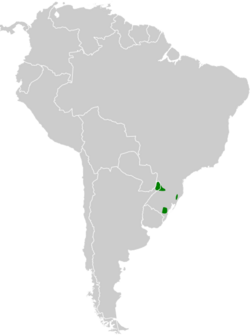Biology:Planalto tapaculo
| Planalto tapaculo | |
|---|---|

| |
| Scientific classification | |
| Domain: | Eukaryota |
| Kingdom: | Animalia |
| Phylum: | Chordata |
| Class: | Aves |
| Order: | Passeriformes |
| Family: | Rhinocryptidae |
| Genus: | Scytalopus |
| Species: | S. pachecoi
|
| Binomial name | |
| Scytalopus pachecoi Maurício, 2005
| |

| |
The Planalto tapaculo (Scytalopus pachecoi) is a small passerine bird in family Rhinocryptidae. It is found in southeastern Brazil and extreme northeastern Argentina .[2]
Taxonomy and systematics
The Planalto tapaculos was previously included in the mouse-colored tapaculo (Scytalopus speluncae) but was described as a new species in 2005 based on differences in plumage and vocalizations. Its specific epithet honors Fernando Pacheco, a Brazilian ornithologist.[3][4][5]
Description
The Planalto tapaculo is about 12 cm (4.7 in) long and weighs about 15 g (0.53 oz). The male's upperparts are mainly dark gray and the underparts paler gray. The flanks are buff with dark bars, which differentiate it from the similar but unbarred mouse-colored tapaculo. The female is browner and the juvenile has not been described.[5]
Distribution and habitat
The Planalto tapaculo is known from southern Brazil (several parts of Rio Grande do Sul and southeastern Santa Catarina) and extreme northeast Misiones Province of Argentina . It inhabits forest and forest edge where it is often found near streams and in undergrowth such as bamboo thickets. It has been found at higher densities in secondary forest than in undisturbed forest. It ranges up to 1,500 m (4,900 ft) elevation.[3][5]
Behavior
Feeding
The Planalto tapaculo forages for arthropods in the forest understory, primarily in thickets of terrestrial bromeliads and bamboo.[5]
Breeding
Almost nothing is known about the Planalto tapaculo's breeding phenology. A nest found in September in Argentina was not described but contained two eggs.[5]
Vocalization
The Planalto tapaculo's song contains a long series of notes starting at a rate of two or three per second and accelerating into a trill [1]. This compares to five notes per second in the faster song of the mouse-colored tapaculo. The Planalto tapaculo has a distinctive, monosyllabic contact call and a loud alarm call.[3][5]
Status
The IUCN has assessed the Planalto tapaculo as being of Least Concern. Though it has a fairly small and scattered distribution, it occurs in several protected areas and reaches its highest density in second growth and disturbed forest.[1][5]
References
- ↑ 1.0 1.1 BirdLife International (2016). "Scytalopus pachecoi". IUCN Red List of Threatened Species 2016: e.T22734687A95094948. doi:10.2305/IUCN.UK.2016-3.RLTS.T22734687A95094948.en. https://www.iucnredlist.org/species/22734687/95094948. Retrieved 20 November 2021.
- ↑ Gill, F.; Donsker, D.; Rasmussen, P. (January 2021). "IOC World Bird List (v 11.1)". http://www.worldbirdnames.org/.
- ↑ 3.0 3.1 3.2 Maurício, Giovanni Nachtigall (2005). "Taxonomy of new populations in the Scytalopus speluncae group, with description of a new species and remarks on the systematics and biogeography of the complex (Passeriformes: Rhinocryptidae)". Ararajuba 13 (1): 7–28. http://www4.museu-goeldi.br/revistabrornito/revista/index.php/BJO/article/view/2101/pdf_309. Retrieved 27 April 2021.
- ↑ Remsen, J. V., Jr., J. I. Areta, E. Bonaccorso, S. Claramunt, A. Jaramillo, D. F. Lane, J. F. Pacheco, M. B. Robbins, F. G. Stiles, and K. J. Zimmer. Version 19 January 2021. A classification of the bird species of South America. American Ornithological Society. http://www.museum.lsu.edu/~Remsen/SACCBaseline.htm retrieved January 19, 2021
- ↑ 5.0 5.1 5.2 5.3 5.4 5.5 5.6 Fjeldså, J. and G. M. Kirwan (2020). Planalto Tapaculo (Scytalopus pachecoi), version 1.0. In Birds of the World (J. del Hoyo, A. Elliott, J. Sargatal, D. A. Christie, and E. de Juana, Editors). Cornell Lab of Ornithology, Ithaca, NY, USA. https://doi.org/10.2173/bow.platap1.01 retrieved April 27, 2021
Wikidata ☰ Q1275555 entry
 |


